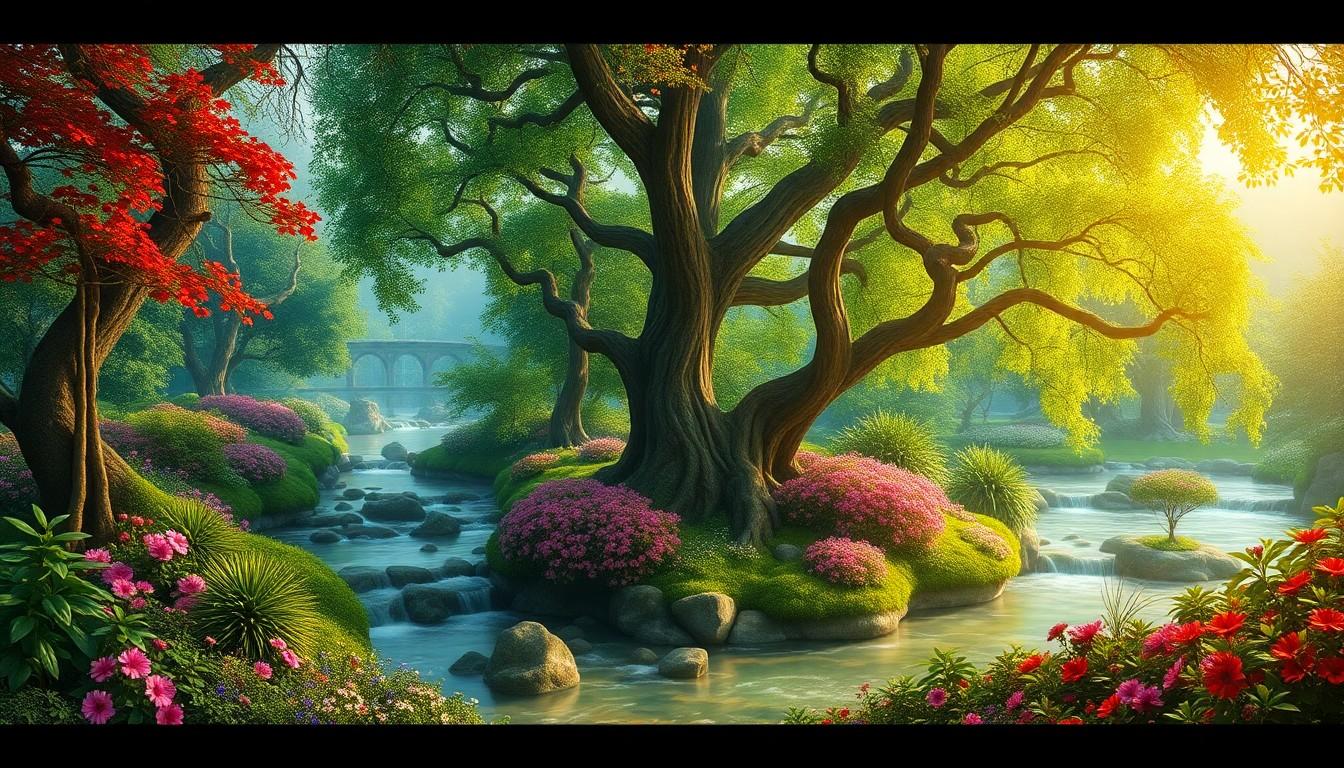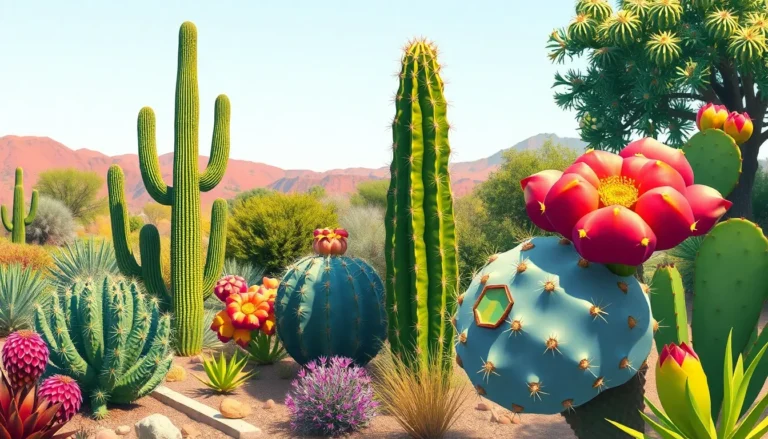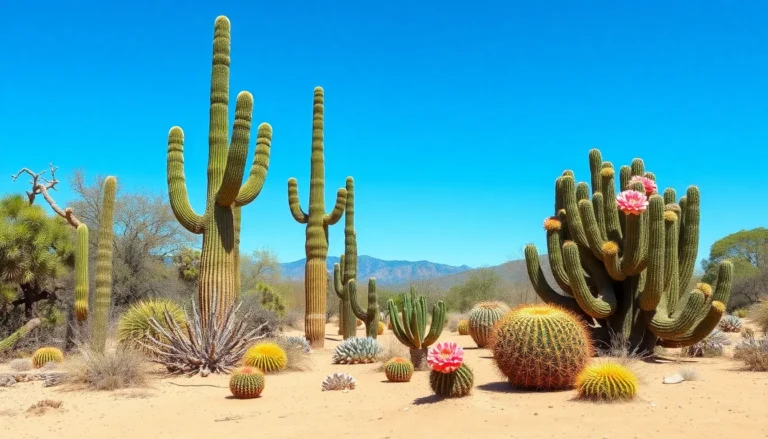Imagine a paradise so lush and vibrant that even Mother Nature would raise an eyebrow in envy. The Garden of Eden, often depicted as the ultimate escape, has sparked curiosity and debate for centuries. Was it a tropical oasis filled with exotic fruits or a serene sanctuary where animals roamed freely?
The Garden of Eden: An Overview
Descriptions of the Garden of Eden highlight its rich beauty and natural abundance. This paradise likely featured diverse vegetation, including various trees with colorful fruits. Ancient texts note that its location was near four rivers: Pishon, Gihon, Tigris, and Euphrates, linking it to the region of Mesopotamia.
Vivid imagery paints the garden as a harmonious ecosystem filled with flora and fauna. Scholars suggest it included significant trees like the Tree of Knowledge and the Tree of Life, contributing to its sacred nature. Animals roamed freely, fostering a tranquil environment and reinforcing the theme of unity between humans and nature.
Cultivation likely occurred within its borders, with early inhabitants tending to the land. Crops may have thrived due to the fertile soil and favorable climate. The garden stood as a symbol of paradise, embodying an ideal coexistence amid an abundance of resources.
Interpretations vary regarding its actual appearance and function. Symbolic meaning often accompanies the idea of the garden, representing innocence and divine connection. Numerous cultures and religious traditions reference the Garden of Eden, embedding it deeply within human consciousness.
Artifacts from archaeological sites indicate similarities to descriptions of the garden. Researchers continue exploring these findings, seeking insights into humanity’s earliest civilizations and their relationship with nature. Unraveling the mysteries of this legendary garden reveals the ways it shaped cultural narratives and beliefs across generations.
Historical Context

The Garden of Eden serves as a critical concept in many ancient narratives, revealing insights into human origins and cultural beliefs. These stories have shaped perceptions of paradise throughout history.
Ancient Texts and Interpretations
Biblical texts provide foundational descriptions of the Garden of Eden, primarily found in the Book of Genesis. Scholars analyze these writings, noting the imagery of lush landscapes filled with trees and rivers. The Tree of Knowledge and the Tree of Life stand out as symbols of divine wisdom and everlasting life. Other ancient documents from diverse cultures offer interpretations that highlight a shared vision of paradise, often correlating beauty with innocence. Overall, these accounts foster discussions about humanity’s relationship to nature and spirituality.
Archaeological Evidence
Archaeological discoveries in Mesopotamia lend credibility to the descriptions of the Garden of Eden. Researchers unearth remnants that align with the lush environments depicted in ancient texts. Significant findings include artifacts suggesting advanced agricultural practices and irrigation systems. Scholars connect these discoveries to notions of a fertile crescent where early civilizations thrived, resonating with the lush greenery associated with the garden. Such evidence stimulates debates about the historical and cultural importance of this mythical paradise.
Descriptions of the Garden
The Garden of Eden’s description evokes images of an extraordinary paradise filled with life and beauty. Ancient texts and scholarly interpretations highlight various features that make this garden unique.
Flora and Fauna
Diverse vegetation flourished within the garden, featuring an array of trees, plants, and vibrant flowers. Significant trees, such as the Tree of Knowledge and the Tree of Life, held special importance in biblical texts. Numerous exotic fruits likely grew from these trees, offering sustenance and symbolic value to early inhabitants. Wildlife also thrived, as animals roamed freely throughout the landscape. This harmonious ecosystem created a tranquil environment, emphasizing the unity between humans and nature.
Geographical Features
Four rivers—Pishon, Gihon, Tigris, and Euphrates—served as essential geographical markers, suggesting a connection to Mesopotamia. These waterways likely nourished the land, contributing to its fertility and lushness. Rolling hills and valleys might have characterized the terrain, enhancing the garden’s enchanting appearance. Archaeological findings indicate that such locations experienced favorable climates. Historical evidence links these natural features to the fertile crescent, illustrating why early civilizations were drawn to this mythic paradise.
Religious Significance
The Garden of Eden holds substantial religious significance across various traditions. Many cultures incorporate the garden into their narratives, often portraying it as a symbol of paradise and a profound connection to the divine.
Symbolism in Different Cultures
Different cultures infuse the Garden of Eden with unique symbolic meanings. In Christianity, it represents innocence and the ideal state of humanity. Similarly, in Judaism, it embodies a harmonious relationship between God and creation. Mesopotamian cultures often view it as a representation of fertility and abundance, mirroring their agricultural societies. Symbolic trees within the garden, like the Tree of Knowledge, signify moral choices and the complexities of human existence. Overall, interpretations draw on the garden’s vibrant imagery and its association with life-giving elements.
Theological Interpretations
Theological interpretations of the Garden emphasize its profound spiritual implications. Many scholars regard it as a foundational narrative outlining humanity’s relationship with God. The presence of significant trees evokes discussions about knowledge, life, and free will. Furthermore, interpretations concerning the fall from grace illuminate the consequences of disobedience. The garden serves as a backdrop for debates on sin and redemption. Various religious texts expand on these themes, reflecting humanity’s quest for understanding and connection to the divine. Ultimately, the Garden of Eden symbolizes a pivotal moment in religious consciousness, shaping beliefs and doctrines throughout history.
Modern Perspectives
Modern interpretations of the Garden of Eden bridge ancient narratives and contemporary thought. Scholars explore its significance through various lenses including science and art.
Scientific Theories
Scientific theories propose diverse hypotheses regarding the geographical and ecological nature of the Garden. Some scientists suggest it may correspond to a specific location in the fertile crescent, based on ancient river descriptions. Genetic studies of early agriculture reveal origins that align with the abundant vegetation mentioned in texts. Theories emphasize climatic conditions that supported diverse flora and fauna, further supporting the idea of a lush paradise. Researchers combine geology and archaeology, examining findings that indicate a rich ecosystem, bolstering connections to profound human histories.
Artistic Representations
Artistic representations of the Garden of Eden capture its essence through visual media. Painters, poets, and sculptors often portray its idyllic landscapes filled with vibrant colors and intricate details. Many artists draw inspiration from biblical texts and cultural reflections, showcasing the garden’s symbolic themes of innocence and beauty. Iconic pieces, such as those by Botticelli and Bruegel, visualize the harmony between humanity and nature within this paradise. Creative expressions continue to evoke powerful interpretations, influencing perceptions of the garden across cultures and eras.
Conclusion
The Garden of Eden remains an enduring symbol of paradise and humanity’s connection to nature. Its lush landscapes and diverse ecosystems capture the imagination and inspire countless interpretations across cultures. The garden’s significance extends beyond its physical description; it represents ideals of innocence, harmony, and divine connection that resonate throughout history.
As researchers continue to explore archaeological findings and ancient texts, the allure of the Garden of Eden persists. It serves as a reminder of humanity’s quest for understanding and the timeless relationship between people and the natural world. The garden’s legacy will likely continue to shape cultural narratives and beliefs for generations to come.




